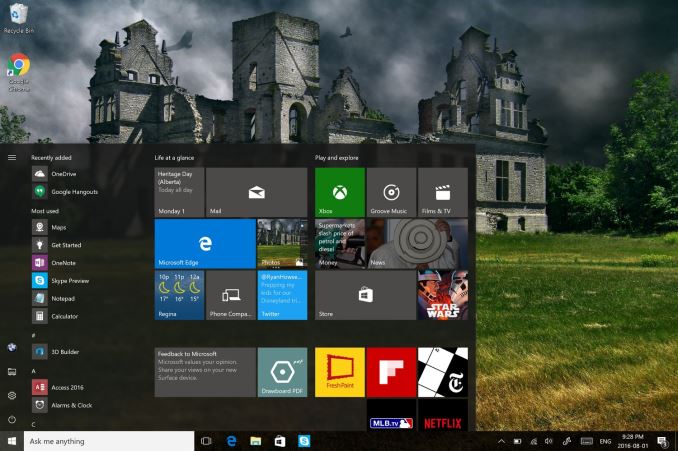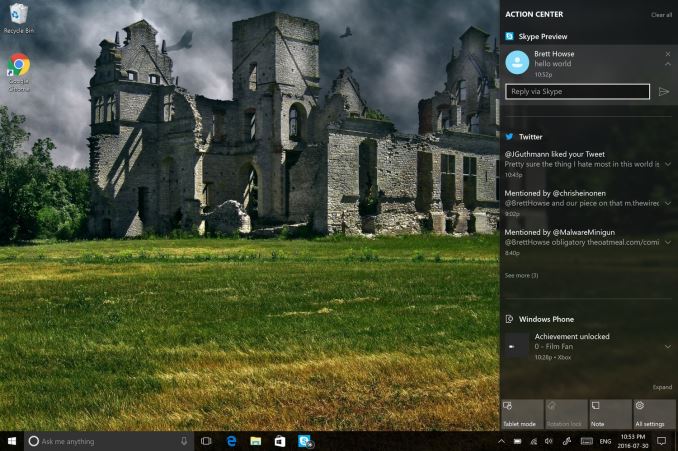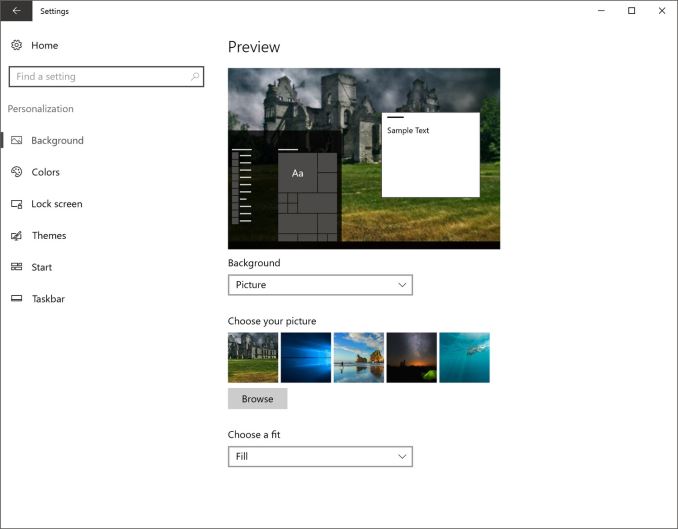Windows 10 Anniversary Update: The Road To Redstone
by Brett Howse on August 2, 2016 8:00 AM EST- Posted in
- Operating Systems
- Microsoft
- Windows 10
Windows 10 Gets Polished
When Windows 10 launched, Microsoft set it up to be “Windows as a Service”. The goal of W10 was for it to be continually updated going forward. In 2015, this is pretty much the default for any new software, which relies on a connected world to always allow constant updates. Windows previous to 10 were patched for security fixes every month, but other than the rare service pack which brought feature updates, what you saw on day one was pretty much what you got when the operating system went out of support. This has changed in a big way with Windows 10. A few months after release, it saw its first feature update to build 1511. This was a small update, but it brought a lot of nice fixes that didn’t make it in time for launch.
The Anniversary Update is an extension of this, bringing a lot of polish to the operating system. Windows 10 didn’t ship in a broken state, but there were certainly a lot of areas where you could see it wasn’t quite done. They’ve made quite a few tweaks for this round, and many of them are quite welcome, while others are purely aesthetic.
Start Menu Changes
The Start Menu has been a work in progress ever since it made its way back to Windows with the Windows 10 launch. Throughout the insider builds, there were quite a few iterations of the start menu, and even with the 1511 update in late 2015, Microsoft updated it to add the ability to add more tiles.
With the Anniversary Update, they are at it again. The biggest change is the 'All Apps' option, which is now gone. All of the apps now default to showing in the Start Menu in a scrollable list, with the most used and recently added apps at the top. The 'Recently Added' option now also shows three apps, which is a nice change. Keeping all of the apps accessible makes it easier to navigate to them. You can of course still just type the name of the app as well, and it will populate from an indexed search.
Action Center Updates
The Action Center gets some nice changes as well. The icon has been subtly tweaked, and it now shows how many notifications you have. The notifications have been increased in size, and Windows 10 now allows you to set priority levels for notifications, so your most important ones are always on top. With apps like Skype, you can reply in-line with the notification, either through the toast pop-up when it first arrives, or later through the Action Center.
Microsoft demoed Universal Dismiss and Notification Mirroring at the Build developer conference, which will allow for notifications dismissed on one device to mirror that dismissal to all devices, and that’s made it into this update. One tip for Windows 10 notifications: if you have an app that spams notifications, you can right click it in the Action Center and turn off notifications for that app. This existed prior to this update as well, but it’s a very handy trick so I figured I’d mention it.
Settings Gets Icons
This is a small change, but Settings was completely text based in Windows 10 until this update. Now, there are icons for each setting. In addition, some of the settings have been broken out a bit better into their own categories.
For example, if you want to join the Windows Insider Program, that has its own category under Update & Security, rather than under and Advanced menu for Updates themselves. Settings continues to offer the search function as well, which makes it much quicker to find any setting.
Lock Screen Changes
The Lock Screen has always been a bit of an odd thing in Windows 10. It’s origins are from the mobile side, where notifications and detailed status updates can be quickly seen when you power on your phone. On a tablet or phone, this is likely more useful than on the desktop, but since Windows 10 is the same OS across all of those devices, the lock screen updates are of course across all devices. The new lock screen now integrates Cortana, and the image on the lock screen is now the same one as the log-in screen, meaning it’s a less jarring experience to unlock the PC. The two images was always a bit odd. These are small changes, but a lot of this update is about making a more consistent experience, so they fit well.













194 Comments
View All Comments
jlabelle2 - Tuesday, August 16, 2016 - link
- how many of us want a private, customizable (think no Cortana / Store / forced updates / automatic removal of programs) OS?It is not because they are idiot people out there that Microsoft should cater their OS for those.
Cortana is nothing more than a search if you disable all the tailor made options.
Removing Windows Store is like asking that OS would run without softwares and cars without wheels. Store apps have inherent advantages compared to Win32 programs (more secured, uninstall without leftovers, free up memory automatically, scale perfectly, support all input types, integrate with notification center / share API / Cortana, roam the settings accrias devices...) that make them (when they do what you want) factually better that Win32 programs. Nobody is forcing anyone to install them but removing the Store is just an utterly silly request.
And at last, regarding automatic updates, we all know, reading those forums what is the perception of average Joe toward Windows PCs being prone to viruses / malwares / slow down compared to tablets like iPad and this is the smartest decision from Microsoft to force update and back in Windows Defender plus Store apps to give people the same advantages as iPad in term of simplicity / security / continuity of performance while still allowing users to use the millions of legacy Win32 programs if necessary.
jlabelle2 - Tuesday, August 16, 2016 - link
What is Cortana if you removed all points of interest except a glorified search? Why people are asking the possibility to disable Cortana? This is beyond me especially people that do think they understand computer better that my mom. Do not want to use search, do not. Simply as that.looncraz - Tuesday, August 2, 2016 - link
This is basically an article highlighting all of the things I remove from Windows 10 to make it a palatable platform. Except Bash.Dark mode also works in the original Windows 10, you just have to manually set a registry key.
baka_toroi - Tuesday, August 2, 2016 - link
Call me paranoid, but I see the combination of project Centennial and the impossibility of rejecting Windows updates as a surefire way to block Win32 apps in the distant future. "We know better than you, boy. Don't try to do as you wish to do with your own computer." In other words, an Apple world.Sure, there will be jailbreaks and stuff but we all know it's not the same as having legitimate access to your whole system.
Michael Bay - Tuesday, August 2, 2016 - link
That day sure is coming, but not any time soon. Way too much legacy sw still in active circulation.prophet001 - Tuesday, August 2, 2016 - link
Why do people just swallow this hook line and sinker?I know why: Ignorance.
Michael Bay - Tuesday, August 2, 2016 - link
If you`re not using some banking client from 80s, there is little use in holding on tightly to win32. It`s not like they are restricting your ability to develop under winrt and will likely start some kind of transition program for developers like Apple did.Ascaris - Wednesday, August 3, 2016 - link
Win32 programs are for regular desktop or laptop PCs. UWP is for tablets and phones. There's already too much of the horrendous UWP "design language" in desktop Windows 10-- I'm certainly never going to add to it with anything "app." When I had a Windows 10 installation on my test PC, I uprooted Windows Store, Cortana, Edge, and all of that kind of stuff... most satisfying thing I ever did with 10, other than wiping the drive when I finally gave up on 10 ever becoming a usable OS.All the stuff about "it uninstalls cleanly" that we hear about UWP is certainly a good thing, but there's nothing inherent about Win32 that makes this inevitable (other than the existence of the registry in general). In the Win 95 days and prior, Windows pretty much allowed any installer to make any change it wanted. It was common for installers to sprinkle DLLs into the Windows directory, sometimes overwriting system files. They were allowed to do most anything with the registry. There was no enforced or even theoretical schema to any of it... it was just "do whatever you want."
A big part of Windows 95's crashiness can probably be directly attributed to this.
Later versions tightened it up some, but installers still have considerable authority to make changes that are not adequately tracked by the system. That doesn't have to be.
If the changes with UWP were mainly about fixing this, that would be one thing, but that's not the main reason for it. It's so "apps" can run on multiple platforms. Maybe some people will be happy running phone apps on their PCs, but I won't. Too many compromises have to be made to make it sorta-work on devices as dissimilar as a touch-screen 5 inch phone (that is usually held in portrait) and a PC with three times the CPU and GPU power and nearly unlimited local storage with a 24" screen that is always in landscape, with input via an actual keyboard and a mouse.
Of course, I know that the idea is that some "apps" will be strictly PC, but those are not the point of UWP. The point is trying to unify dissimilar and ergonomically incompatible computing platforms, even though there are good reasons why PC and mobile UI design parameters are different and distinct.
jlabelle2 - Tuesday, August 16, 2016 - link
- Win32 programs are for regular desktop or laptop PCs. UWP is for tablets and phonesThis cannot be further of the truth. This is an arbitrary split that you are spreading as if everything should be split like Apple decided (even if they are themselves coming back from those toaster/fridge complain as the iPad Pro is proving).
The one advantage you claim from UWP is real. And many others are. It seems that you would have liked Microsoft to evolve Win32 to integrate all the UWP advantages than starting from scratch. Whatever was the best way to proceed, UWP offers clear and undeniable advantages, even purely on desktop compared to Win32 apps (see some that I mentioned above).
- It's so "apps" can run on multiple platforms
Exactly. And as such, that is already a very important advantage that Win32 does not share. And honestly, mobile being so important these days, it is clear that it is much more clever from Microsoft to push applications that could run as well on laptop, tablet or even mobile phone than legacy Win32 softwares.
- Maybe some people will be happy running phone apps on their PCs, but I won't
I am. Because there are nothing specifically phone related. For instance, Drawboard PDF has simply no Win32 equivalent. And there are plenty examples of those.
And there is no reason why phone apps advantages would not be valid when used on a tablet or desktop or laptop.
- Too many compromises have to be made to make it sorta-work on devices as dissimilar as a touch-screen 5 inch phone
Not really as the interface can morph and adapt to the screen size so indeed, UWP are quite flexible on tis regard. You are trying to create a dichotomy that simply does not exist anymore.
Many people are using tablet or laptop with touchscreen. Keyboard is natural input method, even on phones (be it on-screen keyboard). Pen can act virtually like a pointing device making applications benefiting from a mouse very much as usable with a pen on a tablet.
Also, even if laptop or desktop have bigger screen, they are also used from further away.
You are mentioning the aspect ratio but this is something UWP manage very well. A good example is for instance Outlook which is using 3 different vertical panes on phones (account and forlder list,mail list, mail content pane) that can be all displayed at once on a desktop / laptop landscape screen.
Indeed, UWP is an evidence that there is so much overlap that the distinction that Apple is still trying to promote (even if contradicting themselves with the iPad Pro) is not making sense anymore. Google has realize that as well with Android apps running on Chromebook.
- here are good reasons why PC and mobile UI design parameters are different and distinct.
If there were "PC" on one side and "mobile" on an another, where does tablets and laptop fits ?
Daniel Egger - Tuesday, August 2, 2016 - link
lol, Microsoft passed Apple a *long* time ago when it comes to restrictiveness and lack of privacy. Actually it was right at the time when they introduced "Genuine Advantage"...